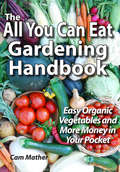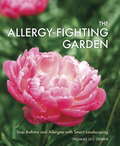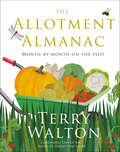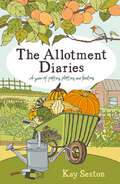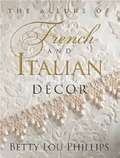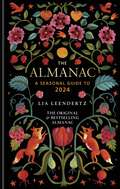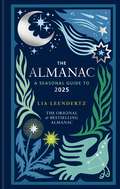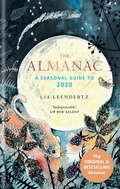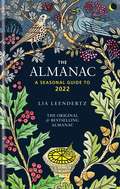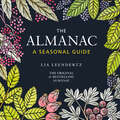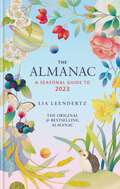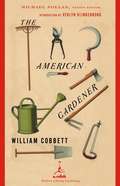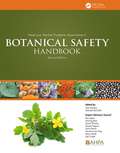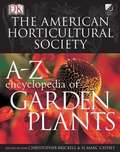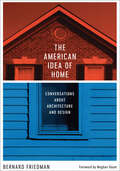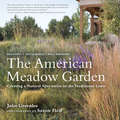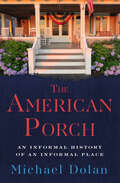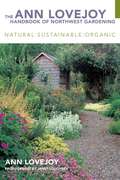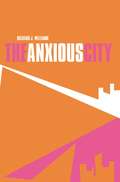- Table View
- List View
The All You Can Eat Gardening Handbook
by Cam MatherThere's never been a better time to grow your own food as we face the converging challenges of the financial crisis, climate change, water shortages, peak oil, and 6.5 billion people worldwide competing for a limited amount of food.Many gardening books are so technical that they are intimidating to the beginning gardener. This book shows how easy gardening can be while providing tips and techniques to ensure success. Whether you live in the country, the city, or the suburbs, you'll learn:How to create lots of rich compost as the basis for vigorous growth Simple techniques to safely deal with pests The most effective techniques for irrigation, including harvesting your rainwater How to store your harvest using canning, freezing, and drying techniques How to build and stock a root cellar How to choose which vegetables to grow based on their nutritional valueThis book is a step-by-step guide to turning your lawn into a great source of personal satisfaction and economic independence. Having an organic produce department in your backyard creates your own "one hundred-foot diet" to reduce your carbon footprint and keep more money in your pocket.Cam Mather has been gardening organically and market gardening for thirty-five years. His entertaining and informative workshops and DVD have inspired thousands of people to get out and get their hands dirty. He publishes books about renewable energy and sustainability from his off-grid solar and wind-powered home office.
The Allergy-Fighting Garden
by Thomas Leo OgrenThe Groundbreaking Guide to Health-Conscious Gardening If you are one of the millions of people with allergies or asthma, this totally unique book shows you how to avoid plants that trigger allergies and to create a garden that will actually protect you by trapping pollen and cleaning the air around you. This revolutionary approach combines the best of horticulturist Thomas Ogren's previous books--Allergy-Free Gardening and Safe Sex in the Garden--into a full-color guide, including hundreds of new and updated plant listings and photographs. Ogren's innovative system for combating allergens is based on the crucial matter of plant sex. By replacing troublesome male plants in your yard with pollen-blocking female "pollen screens," allergy sufferers can reduce or eliminate their symptoms. More than 3,000 plant listings are included, accompanied by an easy-to-use allergy ranking scale of 1 to 10. With many new pollen-free plants to choose from, as well as clearly marked "worst offenders" to avoid, this is the ultimate resource for home gardeners and professionals alike who want to build healthy, safe, and beautiful gardens that everyone can enjoy.From the Trade Paperback edition.
The Allotment Almanac: a month-by-month guide to getting the best from your allotment from much-loved Radio 2 gardener Terry Walton
by Terry WaltonThe ultimate guide for all keen gardeners and allotmenteers - The Allotment Almanac by BBC Radio 2 gardener Terry Walton gives key advice on what to do each month, key crops, main tasks and top tips of varieties and is shot through with distilled hard-won experience. Entertaining and informative, you won't need anything else!'The perfect companion for any allotmenteer, and with Terry Walton, you can't go wrong. His friendly advice will guide you each month, with exactly what you should do on your plot' -- English Garden'This super little book... for all keen gardeners, especially allotmenteers, who will appreciate the tales but also get some useful tips' -- Kitchen Garden'What a lovely little book. Takes you through month by month and really well illustrated. Really pleased with it' -- ***** Reader review'The only companion you will need in the allotment' -- ***** Reader review'A VERY good book, written from the heart, by a knowledgeable gardener' -- ***** Reader review'A must-have for gardeners' -- ***** Reader review'As you read this book you feel Terry at your side chatting to you as if on the plot together - a real joy' -- ***** Reader review****************************************************************************************From a gardener who has been working on his allotment for over 50 years, this is a brilliant guide to organic vegetable growing and allotment life in general. Month-by-month BBC Radio 2 gardener Terry Walton give us invaluable advice on:- things to do each month- what to watch out for- key crops for the month- top variety tipsIn addition to this, he peppers this with tales of life on his allotment, creating a charming and heart-warming guide.Taking the gardening reader by the hand and leading them through the gardening year, Terry is the perfect companion, giving technical help, quick tips, reassurance, and plenty of entertainment along the way.What are you waiting for?
The Allotment Diaries: A Year of Potting, Plotting and Feasting
by Kay SextonKay’s diary takes you through a year in the life of an allotment site, from mulching to munching and everything in between. There’s an abundance of horticultural advice for any kitchen gardener, with month-by-month sections on sowing and growing, crop care and allotment tasks, what to harvest and tried and tested seasonal recipes.
The Allure Of French And Italian Decor
by Betty Lou Phillips"The furnishings of France enchant the eye, Italian pieces sing to the soul." --Betty Lou Phillips, ASID <p><p> France and Italy have long been the go-to spots for fashionistas, serious foodies and design mavens. Rich patinas, satisfying earthen hues and myriad natural materials--translate into timeless, unabashedly elegant yet livable rooms appropriate for our times. Award-winning designer Betty Lou Phillips shows how the best from two European countries combine to create la dolce vita--the good life. <p><p> Award-winning designer and best-selling author, Betty Lou Phillips is a professional member of the American Society of Interior Designers. With projects from New York to California, her work has been featured in countless magazines, as well as in her numerous home design books on French and Italian style. Interiors by Design--her 13th design book-is the ultimate guide to home décor. Additionally, she has appeared on the Christopher Lowell Show and the Oprah Winfrey Show. She lives in Dallas, Texas. Betty Lou Phillips is the author of Emily Goes Wild!, an illustrated children's book, and co-author of The Night Before Christmas in Paris. Later this year Gibbs Smith Publisher will release her Night Before Christmas in New York and Night Before Christmas in Texas.
The Almanac: A Seasonal Guide To 2018 (Almanac)
by Lia LeendertzTHE ORIGINAL & BESTSELLING ALMANACReconnect with the seasons in Britain and Ireland with this month-by-month guide to the world around us - including tide tables, sunrises and moon phases; garden feasts, wildlife and folklore; seasonal recipes, snacks and more.The Almanac: A Seasonal Guide to 2024 gives you the tools and inspiration you need to celebrate, mark and appreciate each month of the year in your own particular way.Divided into the 12 months, a set of tables each month gives it the feel and weight of a traditional almanac, providing practical information that gives access to the outdoors and the seasons, perfect for expeditions, meteor-spotting nights and beach holidays. This year's edition focuses on the natural wonders of the garden, celebrating the beautiful flora and fauna at your doorstep. There are also features on each month's unique nature, plus a flower and a snack of the month.You will find yourself referring to The Almanac all year long, revisiting it again and again, and looking forward to the next edition as the year draws to a close.PRAISE FOR THE ALMANAC:'Lia Leendertz's classic almanac never fails to delight' - The Herald'It's a perfect Christmas present' - Allan Jenkins, The Observer'The perfect companion to the seasons' - India Knight'Indispensable' - Sir Bob Geldof'This book is your bible' - The Independent'I love this gem of a book' - Cerys Matthews
The Almanac: A Seasonal Guide To 2018 (Almanac)
by Lia LeendertzTHE ORIGINAL & BESTSELLING ALMANACReconnect with the seasons in Britain and Ireland with this month-by-month guide to the world around us - including tide tables, sunrises and moon phases; garden feasts, wildlife and folklore; seasonal recipes, snacks and more.The Almanac: A Seasonal Guide to 2024 gives you the tools and inspiration you need to celebrate, mark and appreciate each month of the year in your own particular way.Divided into the 12 months, a set of tables each month gives it the feel and weight of a traditional almanac, providing practical information that gives access to the outdoors and the seasons, perfect for expeditions, meteor-spotting nights and beach holidays. This year's edition focuses on the natural wonders of the garden, celebrating the beautiful flora and fauna at your doorstep. There are also features on each month's unique nature, plus a flower and a snack of the month.You will find yourself referring to The Almanac all year long, revisiting it again and again, and looking forward to the next edition as the year draws to a close.PRAISE FOR THE ALMANAC:'Lia Leendertz's classic almanac never fails to delight' - The Herald'It's a perfect Christmas present' - Allan Jenkins, The Observer'The perfect companion to the seasons' - India Knight'Indispensable' - Sir Bob Geldof'This book is your bible' - The Independent'I love this gem of a book' - Cerys Matthews
The Almanac: A Seasonal Guide To 2018 (Almanac)
by Lia LeendertzThe original and bestselling almanacReconnect with the seasons in Britain and Ireland with this month-by-month guide to the world around us - including tide tables, sunrises and moon phases; wildlife and folklore; seasonal recipes and more.The Almanac: A Seasonal Guide to 2025 gives you the tools and inspiration you need to celebrate, mark and appreciate each month of the year in your own particular way.Divided into the 12 months, a set of tables each month gives it the feel and weight of a traditional almanac, providing practical information that gives access to the outdoors and the seasons, perfect for expeditions, meteor-spotting nights and beach holidays. And it's the ideal gift!You will find yourself referring to The Almanac all year long, revisiting it again and again, and looking forward to the next edition as the year draws to a close.PRAISE FOR THE ALMANAC:'Lia Leendertz's classic almanac never fails to delight' - The Herald'It's a perfect Christmas present' - Allan Jenkins, The Observer'The perfect companion to the seasons' - India Knight'Indispensable' - Sir Bob Geldof'This book is your bible' - The Independent'I love this gem of a book' - Cerys Matthews
The Almanac: A Seasonal Guide To 2018 (Almanac)
by Lia LeendertzThe original and bestselling almanacReconnect with the seasons in Britain and Ireland with this month-by-month guide to the world around us - including tide tables, sunrises and moon phases; wildlife and folklore; seasonal recipes and more.The Almanac: A Seasonal Guide to 2025 gives you the tools and inspiration you need to celebrate, mark and appreciate each month of the year in your own particular way.Divided into the 12 months, a set of tables each month gives it the feel and weight of a traditional almanac, providing practical information that gives access to the outdoors and the seasons, perfect for expeditions, meteor-spotting nights and beach holidays. And it's the ideal gift!You will find yourself referring to The Almanac all year long, revisiting it again and again, and looking forward to the next edition as the year draws to a close.PRAISE FOR THE ALMANAC:'Lia Leendertz's classic almanac never fails to delight' - The Herald'It's a perfect Christmas present' - Allan Jenkins, The Observer'The perfect companion to the seasons' - India Knight'Indispensable' - Sir Bob Geldof'This book is your bible' - The Independent'I love this gem of a book' - Cerys Matthews
The Almanac: A Seasonal Guide to 2020
by Lia Leendertz*THE ORIGINAL & BESTSELLING ALMANAC *'Indispensable' - Sir Bob Geldof A perfect toolkit connecting with the world around us and the year ahead as it unfolds - all in a compact and pocket size that just begs you to pick it up and browse.The Almanac: A Seasonal Guide to 2020 reinvents the tradition of the rural almanac for a new audience. It gives you the tools and inspiration you need to celebrate, mark and appreciate each month of the year in your own particular way. Divided into the 12 months, a set of tables each month gives it the feel and weight of a traditional almanac, providing practical information that gives access to the outdoors and the seasons, perfect for expeditions, meteor-spotting nights and beach holidays. There are also features on each month's unique nature, such as the meteor shower of the month, beehive behaviour, folklore and stories, seasonal recipes and charts tracking moon phases and tides. You will find yourself referring to the almanac all year long, revisiting it again and again, and looking forward to the next edition as the year draws to a close. PRAISE FOR THE ALMANAC: A SEASONAL GUIDE:'The perfect companion to the seasons' - India Knight'This book is your bible' - the Independent 'An ideal stocking filler' - The English Garden 'I love this gem of a book' - Cerys Matthews
The Almanac: A Seasonal Guide to 2020
by Lia Leendertz*THE ORIGINAL & BESTSELLING ALMANAC *'Indispensable' - Sir Bob Geldof A perfect toolkit connecting with the world around us and the year ahead as it unfolds - all in a compact and pocket size that just begs you to pick it up and browse.The Almanac: A Seasonal Guide to 2020 reinvents the tradition of the rural almanac for a new audience. It gives you the tools and inspiration you need to celebrate, mark and appreciate each month of the year in your own particular way. Divided into the 12 months, a set of tables each month gives it the feel and weight of a traditional almanac, providing practical information that gives access to the outdoors and the seasons, perfect for expeditions, meteor-spotting nights and beach holidays. There are also features on each month's unique nature, such as the meteor shower of the month, beehive behaviour, folklore and stories, seasonal recipes and charts tracking moon phases and tides. You will find yourself referring to the almanac all year long, revisiting it again and again, and looking forward to the next edition as the year draws to a close. PRAISE FOR THE ALMANAC: A SEASONAL GUIDE:'The perfect companion to the seasons' - India Knight'This book is your bible' - the Independent 'An ideal stocking filler' - The English Garden 'I love this gem of a book' - Cerys Matthews
The Almanac: A seasonal guide to 2022
by Lia Leendertz*THE ORIGINAL & BESTSELLING ALMANAC*A perfect toolkit for connecting with the world around us and the year ahead as it unfolds - all in a compact and pocket size guide that just begs you to pick it up and browse.The Almanac: A seasonal guide to 2022 reinvents the tradition of the rural almanac for a new audience. It gives you the tools and inspiration you need to celebrate, mark and appreciate each month of the year in your own particular way. Divided into the 12 months, a set of tables each month gives it the feel and weight of a traditional almanac, providing practical information that gives access to the outdoors and the seasons, perfect for expeditions, meteor-spotting nights and beach holidays. There are also features on each month's unique nature, such as the meteor shower of the month, beehive behaviour, folklore, seasonal recipes and charts tracking moon phases and tides.You will find yourself referring to The Almanac all year long, revisiting it again and again, and looking forward to the next edition as the year draws to a close.PRAISE FOR THE ALMANAC:'The perfect companion to the seasons' - India Knight'Indispensable' - Sir Bob Geldof'This book is your bible' - The Independent'An ideal stocking filler' - The English Garden'I love this gem of a book' - Cerys Matthews
The Almanac: A seasonal guide to 2022
by Lia Leendertz*THE ORIGINAL & BESTSELLING ALMANAC*A perfect toolkit for connecting with the world around us and the year ahead as it unfolds - all in a compact and pocket size guide that just begs you to pick it up and browse.The Almanac: A seasonal guide to 2022 reinvents the tradition of the rural almanac for a new audience. It gives you the tools and inspiration you need to celebrate, mark and appreciate each month of the year in your own particular way. Divided into the 12 months, a set of tables each month gives it the feel and weight of a traditional almanac, providing practical information that gives access to the outdoors and the seasons, perfect for expeditions, meteor-spotting nights and beach holidays. There are also features on each month's unique nature, such as the meteor shower of the month, beehive behaviour, folklore, seasonal recipes and charts tracking moon phases and tides.You will find yourself referring to The Almanac all year long, revisiting it again and again, and looking forward to the next edition as the year draws to a close.PRAISE FOR THE ALMANAC:'The perfect companion to the seasons' - India Knight'Indispensable' - Sir Bob Geldof'This book is your bible' - TheIndependent'An ideal stocking filler' - The English Garden'I love this gem of a book' - Cerys Matthews
The Almanac: A seasonal guide to 2022
by Lia Leendertz*THE ORIGINAL & BESTSELLING ALMANAC*'Lia Leendertz's classic almanac never fails to delight' - The Herald'It's a perfect Christmas present' - Allan Jenkins, The ObserverA perfect toolkit for connecting with the world around us and the year ahead as it unfolds - all in a compact and pocket size guide that just begs you to pick it up and browse.The Almanac: A seasonal guide to 2022 reinvents the tradition of the rural almanac for a new audience. It gives you the tools and inspiration you need to celebrate, mark and appreciate each month of the year in your own particular way. Divided into the 12 months, a set of tables each month gives it the feel and weight of a traditional almanac, providing practical information that gives access to the outdoors and the seasons, perfect for expeditions, meteor-spotting nights and beach holidays. There are also features on each month's unique nature, such as the meteor shower of the month, beehive behaviour, folklore, seasonal recipes and charts tracking moon phases and tides.You will find yourself referring to The Almanac all year long, revisiting it again and again, and looking forward to the next edition as the year draws to a close.The geographical scope of The Almanac is Britain and IrelandThis audiobook combines content from all Lia Leendertz's Almanacs and is updated annually to include new recipes, tips, stories and seasonal information to accompany you throughout the year. PRAISE FOR THE ALMANAC:'The perfect companion to the seasons' - India Knight'Indispensable' - Sir Bob Geldof'This book is your bible' - The Independent'An ideal stocking filler' - The English Garden'I love this gem of a book' - Cerys Matthews
The Almanac: THE SUNDAY TIMES BESTSELLER (Almanac)
by Lia LeendertzTHE ORIGINAL & SUNDAY TIMES BESTSELLING ALMANAC Reconnect with the seasons in Britain and Ireland with this month-by-month guide to the world around us - including key dates, tide tables and garden tasks; constellations and moon phases; sunrises, folk songs, seasonal recipes plus a 'bun of the month'; and - because 2023 will be a good year for planet spotting - the solar system and the zodiac.The Almanac: A Seasonal Guide to 2023 gives you the tools and inspiration you need to celebrate, mark and appreciate each month of the year in your own particular way. Divided into the 12 months, a set of tables each month gives it the feel and weight of a traditional almanac, providing practical information that gives access to the outdoors and the seasons, perfect for expeditions, meteor-spotting nights and beach holidays. There are also features on each month's unique nature, with this instalment following the swirling micro world of the garden pond through the year.You will find yourself referring to The Almanac all year long, revisiting it again and again, and looking forward to the next edition as the year draws to a close.This year's edition is illustrated by artist Whooli Chen.The geographical scope of The Almanac is Britain and IrelandPRAISE FOR THE ALMANAC:'Lia Leendertz's classic almanac never fails to delight' - The Herald'It's a perfect Christmas present' - Allan Jenkins, The Observer'The perfect companion to the seasons' - India Knight'Indispensable' - Sir Bob Geldof'This book is your bible' - The Independent'I love this gem of a book' - Cerys Matthews
The Almanac: THE SUNDAY TIMES BESTSELLER (Almanac)
by Lia LeendertzTHE ORIGINAL & SUNDAY TIMES BESTSELLING ALMANAC Reconnect with the seasons in Britain and Ireland with this month-by-month guide to the world around us - including key dates, tide tables and garden tasks; constellations and moon phases; sunrises, folk songs, seasonal recipes plus a 'bun of the month'; and - because 2023 will be a good year for planet spotting - the solar system and the zodiac.The Almanac: A Seasonal Guide to 2023 gives you the tools and inspiration you need to celebrate, mark and appreciate each month of the year in your own particular way. Divided into the 12 months, a set of tables each month gives it the feel and weight of a traditional almanac, providing practical information that gives access to the outdoors and the seasons, perfect for expeditions, meteor-spotting nights and beach holidays. There are also features on each month's unique nature, with this instalment following the swirling micro world of the garden pond through the year.You will find yourself referring to The Almanac all year long, revisiting it again and again, and looking forward to the next edition as the year draws to a close.This year's edition is illustrated by artist Whooli Chen.The geographical scope of The Almanac is Britain and IrelandPRAISE FOR THE ALMANAC:'Lia Leendertz's classic almanac never fails to delight' - The Herald'It's a perfect Christmas present' - Allan Jenkins, The Observer'The perfect companion to the seasons' - India Knight'Indispensable' - Sir Bob Geldof'This book is your bible' - The Independent'I love this gem of a book' - Cerys Matthews
The American Gardener: A Treatise On The Situation, Soil And Laying Out Of Gardens (Modern Library Gardening)
by William CobbettOut of print since 1856, The American Gardener is perhaps the first classic work of American gardening literature. In it, William Cobbett, Victorian England's greatest and most gifted journalist, draws upon his experiences during a two-year exile on a Long Island, New York, farm to lay out the rudiments of gardening for American farmers and, ultimately, to tailor principles developed in wet, drippy, weed-prone British gardens to their fine, sun-drenched counterparts in America. Full of practical knowledge memorably imparted with Cobbett's gift for the indelible phrase, The American Gardener offers advice still useful today on all aspects of gardening, with special attention to those plants successful in the New World, including the artichoke ( indeed, a thistle upon a gigantic scaleo) and the increasingly ubiquitous potato. Rediscovered 180 years after its composition, The American Gardener is evidence of a great mind and pen at work in the earliest days of American gardens. This Modern Library edition is published with a new Introduction by Verlyn Klinkenborg, a New York Times editorialist and the author of The Rural Life, Making Hay, and The Last Fine Time.
The American Herbal Products Association Botanical Safety Handbook
by Zoe Gardner Michael McGuffin<p>Access to accurate, evidence-based, and clinically relevant information is essential to anyone who uses or recommends herbal products. With input from some of the most respected experts in herbal and integrative medicine, this completely revised edition of the American Herbal Products Association’s Botanical Safety Handbook reviews both traditional knowledge and contemporary research on herbs to provide an authoritative resource on botanical safety. The book covers more than 500 species of herbs and provides a holistic understanding of safety through data compiled from clinical trials, pharmacological and toxicological studies, medical case reports, and historical texts. <p>For each species, a brief safety summary is provided for quick reference, along with a detailed review of the literature. Easily understood classification systems are used to indicate the safety of each listed species and the potential for the species to interact with drugs</p>
The American Horticultural Society A to Z Encyclopedia of Garden Plants (Revised American Edition)
by Christopher Brickell H. Marc CatheyAmerican Horticultural Society A to Z Encyclopedia of Garden Plants is a comprehensive, detailed, and illustrated alphabetical guide to some 15,000 ornamental plants and an essential reference for all gardeners and horticulturists. Easy to Use Plants are arranged alphabetically by their botanical names for fast, straightforward access, and previous names and common names appear as cross-references throughout the main text.
The American Idea of Home: Conversations about Architecture and Design
by Bernard Friedman“Home is an idea,” Meghan Daum writes in her foreword, “a story we tell ourselves about who we are and who and what we want closest in our midst.” In The American Idea of Home, documentary filmmaker Bernard Friedman interviews more than thirty leaders in the field of architecture about a constellation of ideas relating to housing and home. The interviewees include Pritzker Prize winners Thom Mayne, Richard Meier, and Robert Venturi; Pulitzer Prize winners Paul Goldberger and Tracy Kidder; American Institute of Architects head Robert Ivy; and legendary architects such as Denise Scott Brown, Charles Gwathmey, Kenneth Frampton, and Robert A. M. Stern. The American idea of home and the many types of housing that embody it launch lively, wide-ranging conversations about some of the most vital and important issues in architecture today. The topics that Friedman and his interviewees discuss illuminate five overarching themes: the functions and meanings of home; history, tradition, and change in residential architecture; activism, sustainability, and the environment; cities, suburbs, and regions; and technology, innovation, and materials. Friedman frames the interviews with an extended introduction that highlights these themes and helps readers appreciate the common concerns that underlie projects as disparate as Katrina cottages and Frank Lloyd Wright Usonian houses. Readers will come away from these thought-provoking interviews with an enhanced awareness of the “under the hood” kinds of design decisions that fundamentally shape our ideas of home and the dwellings in which we live.
The American Idea of Home: Conversations about Architecture and Design
by Bernard FriedmanOver thirty leaders in American architecture discuss the most significant issues in the field today.&“Home is an idea,&” Meghan Daum writes in her foreword, &“a story we tell ourselves about who we are and who and what we want closest in our midst.&” In The American Idea of Home, documentary filmmaker Bernard Friedman interviews more than thirty leaders in the field of architecture about a constellation of ideas relating to housing and home. The interviewees include Pritzker Prize winners Thom Mayne, Richard Meier, and Robert Venturi; Pulitzer Prize winners Paul Goldberger and Tracy Kidder; American Institute of Architects head Robert Ivy; and legendary architects such as Denise Scott Brown, Charles Gwathmey, Kenneth Frampton, and Robert A. M. Stern. The American idea of home and the many types of housing that embody it launch lively, wide-ranging conversations about some of the most vital and important issues in architecture today. The topics that Friedman and his interviewees discuss illuminate five overarching themes: the functions and meanings of home; history, tradition, and change in residential architecture; activism, sustainability, and the environment; cities, suburbs, and regions; and technology, innovation, and materials. Friedman frames the interviews with an extended introduction that highlights these themes and helps readers appreciate the common concerns that underlie projects as disparate as Katrina cottages and Frank Lloyd Wright Usonian houses. Readers will come away from these thought-provoking interviews with an enhanced awareness of the &“under the hood&” kinds of design decisions that fundamentally shape our ideas of home and the dwellings in which we live.
The American Meadow Garden: Creating a Natural Alternative to the Traditional Lawn
by Saxon Holt John GreenleeIf there's one lesson every homeowner must learn, it's this: The traditional lawn is a huge, time consuming, synthetic-chemical sucking mistake. The time has come to look for new ways to create friendly, livable spaces around our homes. In The American Meadow Garden, ornamental grass expert John Greenlee creates a new model for homeowners and gardeners. For Greenlee, a meadow isn't a random assortment of messy, anonymous grasses. Rather, it is a shimmering mini-ecosystem, in which regionally appropriate grasses combine with colorful perennials to form a rich tapestry that is friendly to all life — with minimal input of water, time, and other scarce resources. Kids and pets can play in complete safety, and birds and butterflies flock there. A prairie style planting is a place you want to be. With decades of experience as a nurseryman and designer, John Greenlee is the perfect guide. He details all the practicalities of site preparation, plant selection, and maintenance; particularly valuable are his explanations of how ornamental grasses perform in different climates and areas. Gorgeous photography by Saxon Holt visually illustrates the message with stunning examples of meadow gardens from across the country. We've reached a stage where we can no longer follow past practices unthinkingly, particularly when those practices are wasteful and harmful to the environment. It's time to get rid of the old-fashioned lawn and embrace a sane and healthy future: the American meadow garden.
The American Porch: An Informal History of an Informal Place
by Michael DolanThe former American History editor explores the creation and restoration of an essential part of a twentieth-century home&’s identity—the American porch. &“In this delightful look at an American icon, journalist and documentary scriptwriter . . . Dolan traces the history of the porch, using this history to explore subjects such as architecture, history, slavery, colonialism, trade, anthropology, sociology, consumer behavior, and publishing.&” —Library Journal In 1981, Michael Dolan and his wife, Eileen O&’Toole, bought a 1926 suburban bungalow in the Palisades area of Washington, DC. It was a fixer-upper and DIY project that consumed their lives for twelve years. As rooms were transformed with updated electrical wiring and plumbing, the house&’s porch became a storage area, rotating appliances, furniture, and construction materials as they were used and discarded. After the interior renovation was completed, Michael finally turned his attention to the porch, working with contractors to resurrect it—a reconstruction that inspired him to uncover the history of porches and their significance as a symbolic piece of Americana. &“In praise of the porch: Come up and sit a spell.&” —USA Today &“A wry, well-researched look at the place and the people who rocked, talked and courted on [the American porch] for three centuries.&” —Parade &“The porch is making a comeback, gradually replacing its humbler rival the deck, which the traditionalist Dolan refers to as the platform shoe or leisure suit of American architecture.&” —Time &“Dolan amply demonstrates that the porch is primarily a means of escaping the heat and, almost as important, a locus for casual social interaction.&” —Publishers Weekly
The Ann Lovejoy Handbook of Northwest Gardening
by Ann LovejoyIn this updated second edition of the popular guide, Ann Lovejoy explains how to create a gorgeous ornamental garden following the principles and techniques of organic and sustainable gardening. Emphasizing good soil prep, composting, drainage, mulching, and proper plant selection, the book covers every step from landscaping and design to soil prep to planting beds, all with the goal of creatinga lovely garden without chemical fertilizers or pest control. Janet Loughrey’s color photographs show the splendid results.
The Anxious City: British Urbanism in the late 20th Century
by Richard J. WilliamsIn the Western world, cities have arguably never been more anxious: practical anxieties about personal safety and metaphysical anxieties about the uncertain place of the city in culture are the small change of journalism and political debate. Cities have long been regarded as problems, in need of drastic solutions. In this context, the contemporary revival of city centres is remarkable. But in a culture that largely fears the urban, how can the contemporary city be imagined? How is it supposed to be used or inhabited? What does it mean? Taking England since WWII as its principal focus, this provocative and original book considers the Western city at a critical moment in its history.
